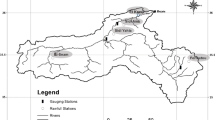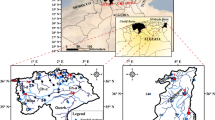Summary
Climatic fluctuations across Africa are analysed from two century+ records of rainfall at Durban, South Africa and the Nile River flow in southern Egypt. A wavelet transform analysis is applied to the rainfall record to determine the strength of intra-seasonal to decadal rhythms. The annual cycle constitutes 33% of variability, whilst 2.3–4 year cycles account for 10% of the variance. A contingency analysis of flood events reveals a bimodal character with peaks in November and March. The Durban rainfall time series is compared with remote environmental variables. Close relationships are found with the meridional gradient of sea surface temperature in the Atlantic and the southern oscillation index. Comparisons are made between the southern summer rainfall at Durban (November–March) and northern summer Nile River flow (July–October). Cross-wavelet analysis of the two records indicates a matching of frequency in quasi-biennial and El Niño frequency bands. This suggests that the uptake of ‘teleconnections’ governing African climate occurs in a widespread manner.
Similar content being viewed by others
Author information
Authors and Affiliations
Additional information
Received February 25, 2000
Rights and permissions
About this article
Cite this article
Jury, M., Melice, JL. Analysis of Durban rainfall and Nile river flow 1871–1999. Theor Appl Climatol 67, 161–169 (2000). https://doi.org/10.1007/s007040070005
Issue Date:
DOI: https://doi.org/10.1007/s007040070005




